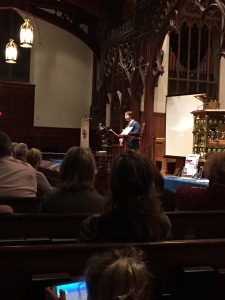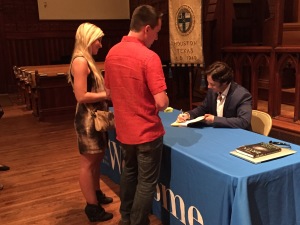David Eagleman talks about the The Brain: The Story of You
October 15, 2015, by Erika Jo Brown
 Last week brought two bright stars of the literary world—David Eagleman and Geraldine Brooks—to Christ Church Cathedral, in partnership with Brazos Bookstore.
Last week brought two bright stars of the literary world—David Eagleman and Geraldine Brooks—to Christ Church Cathedral, in partnership with Brazos Bookstore.
From one perspective, the writers could not be more different. Eagleman is a neuroscientist who directs a research laboratory at Baylor College of Medicine. Brooks is a Pulitzer Prize-winning writer of historical fiction. Yet both explore notions of society, time, vision, and humanism in their writing. And their books have been translated into dozens of languages.
This is the first of a two-part review of the special events.
In Reverend Art Callahan’s welcome to David Eagleman’s reading, he quipped that “at church, we do not leave our brains at the door.” This was a perfect prologue to a fast-paced, multimedia event that held the audience (and their brains) rapt.
Eagleman is clearly passionate about the public understanding of science. He’s written for The New York Times, Discover Magazine, Atlantic, Slate, Wired, discussed new trends on NPR and BBC, and serves as an editor for several scholarly journals.
 In addition, Eagleman is the author of bestselling nonfiction books, including Incognito: The Secret Lives of the Brain, Wednesday is Indigo Blue: Discovering the Brain of Synesthesia, and Why the Net Matters. He’s also written a speculative book of fiction, Sum, which travels through forty vignettes of the afterlife. For this reading, he was celebrating the recent release of The Brain: The Story of You, a companion book to his upcoming television series.
In addition, Eagleman is the author of bestselling nonfiction books, including Incognito: The Secret Lives of the Brain, Wednesday is Indigo Blue: Discovering the Brain of Synesthesia, and Why the Net Matters. He’s also written a speculative book of fiction, Sum, which travels through forty vignettes of the afterlife. For this reading, he was celebrating the recent release of The Brain: The Story of You, a companion book to his upcoming television series.
In her introduction, Houston-based novelist and children’s book author Chris Cander described Eagleman’s “insatiable curiosity about the relationship between the brain and being.” When he took the stage, he jovially characterized his research as studying how “three pounds of jello-like material….somehow produces your sense of reality.”
“Each neuron,” he explained, “is as complicated as the city of Houston. And each is connected to 10,000 of its neighbors.” He went on to add that the complexity of the brain “bankrupts our language.”
Luckily for us, Eagleman brought in audio-visual aids to help communicate the enormity of his findings. Throughout his presentation, he screened snippets of his new PBS special series The Secret Life of the Brain.
Episodes were filmed over the course of two years, with around 60-70% shot in Houston. But the show also took Eagleman around the world to meet his colleagues, in addition to robots, star athletes, people with schizophrenia, families of the victims of genocide, and more.
So how did he get his start? By watching Carl Sagan’s Cosmos as a child, for starters. The program helped tune him into “the beauty of science as a way to understand the world.” He began wondering some of the big questions: How do our brains construct reality? How does it affect our social lives? What will our future look like?
So how did he get his start? By watching Carl Sagan’s Cosmos as a child, for starters. The program helped tune him into “the beauty of science as a way to understand the world.” He began wondering some of the big questions: How do our brains construct reality? How does it affect our social lives? What will our future look like?
Eagleman started writing books seven years ago as a way to disseminate his investigations, but television “was a whole new learning experience,” which he described as “an alchemy of visual pictures and narrative arcs and people’s journeys.” In a way, The Secret Life of the Brain is an homage to “the inner cosmos.”
Truly, he has a special way of seeing and expressing everyday miracles. Eagleman depicts waking up in the morning as a time when “the most conscious animal on the planet becomes aware that it exists.” Reading, from a neuroscientist’s perspective, is “rapid ballistic jumps made from the eyes.” An EEG is “a window into the electric world of our brains.”
 Eagleman is perhaps most animated when chronicling experiments. In one case, he describes a patient’s surgery during which doctors use an audio speaker to broadcast the sounds of neural activity, “like people with different jobs and cultures.” Later, when speaking of a sleep experiment, he notes that “consciousness is a performance that our brain puts on for us each day.”
Eagleman is perhaps most animated when chronicling experiments. In one case, he describes a patient’s surgery during which doctors use an audio speaker to broadcast the sounds of neural activity, “like people with different jobs and cultures.” Later, when speaking of a sleep experiment, he notes that “consciousness is a performance that our brain puts on for us each day.”
“Social behaviors,” he emphasizes, “sit squarely at the center of human success.” He observes that “we are each the sole inhabitant of our own cosmos.” Yet, our cooperation is what makes us, as a species, thrive.
One of his favorite chapters in the new book is about social neuroscience, or the “seven billion deeds of a shifting mega organism.” In the age of digital hyperlinking, Eagleman finds it imperative to study our connections, such as “the neural drive it to form in-groups and out-groups” and “cross-stitching allegiances.”
He fielded questions from the audience, and extemporized about topics ranging from “quantifying the efficacy of different tolerance programs” to tailoring judicial sentences.
He charmingly answered a concerned question about maintaining cognitive health by giving advice on “forcing your brain to exercise”: interact with people, seek novelty, keep your brain challenged and “come to readings.”

